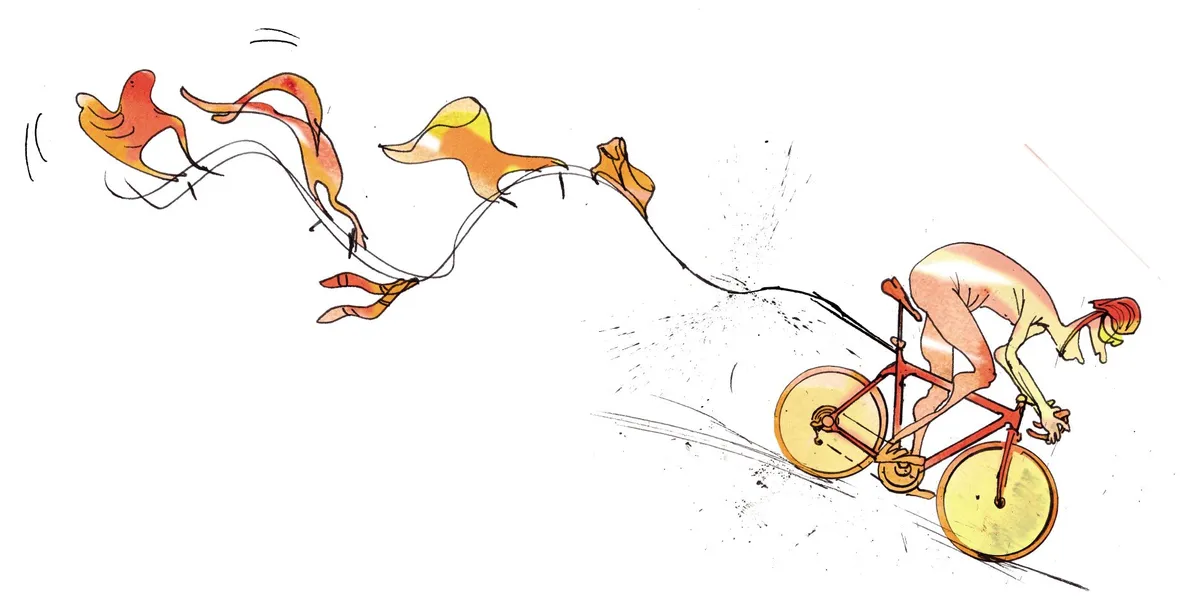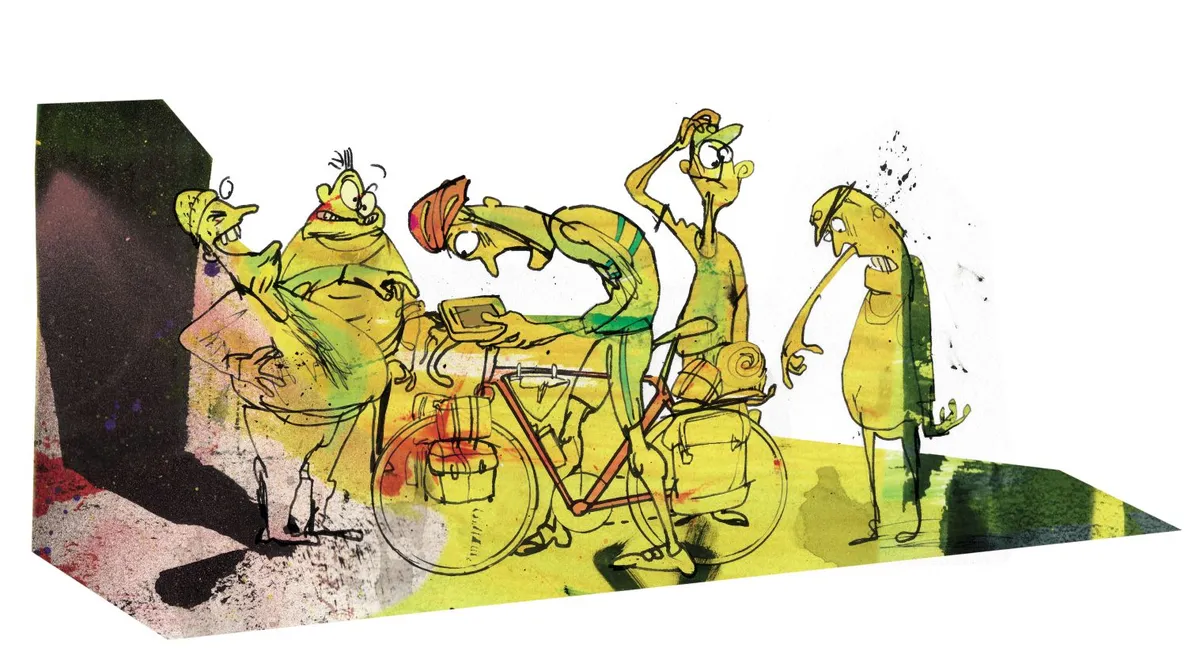Sixteen years ago, I set off to ride the route of the Tour de France without ever having cycled more than 100km in any single day. Unburdened with experience or the entry-level basics of common sense, I cheerfully bulged my carriers with such featherweight touring essentials as the 1124-page Rough Guide to France, several cycling magazines, a waterproof toilet-roll holder and a full wardrobe of après-vélo wear to suit a variety of evening moods. Wobbling tearfully up my first French hillock, I thought, I’m never making this mistake again. Not with so many others to choose from! And so a few summers back, much older and at least slightly wiser, I pedalled away from Milan with everything required for a self-supported, five-week retracing of the 1914 Giro crammed into a modest saddle bag. Slung from a 99-year-old Brooks B17 that would very shortly snap clean in two right under my perineum.
A few provisos before I dish out my cut-out-and-eat guide to planning a long-distance bicycle tour. Let’s assume that you’ve remembered to undertake adequate physical conditioning, which maddeningly always seems to slip my mind. Let’s additionally assume that you know broadly where you want to go, and are familiar with the principle tenets of bicycle touring: ingest breakfast carbs until your face bursts, one bidon carrier isn’t enough, lunchtime drinking is the preserve of the under 35s. Now: come feast on the sour fruits of my labour.

Accommodation
Your first question: am I going to camp? And your first answer: am I bollocks. Beyond the mountain of extra kit to lug about, battling a billowy polyester sail into the sodden, pebbled earth just seems a very poor reward for a long day in the saddle. Itinerant camping without a powered vehicle is a hell that doesn’t bear thinking about. How tragic to recall Captain Scott’s last journal entry, cursing Oates for sneaking off to that Travelodge.
Don’t, however, book any hotels before you go. From fitness to mechanicals – via extreme weather and life-changing injury – there are simply too many variables and unknowns. Before my next trip I’ll be installing one of those room-booking apps on my phone, allowing me to take my late-afternoon pick of proximate accommodation in… oh, in the unpeopled wastelands of signal-free northern Finland.
Bike
That carbon nanotube frame you swapped your nephew for really is a wonder of gossamer-weight, high-end engineering. However, you aren’t, so it’s staying at home. Marginal gains have no place on a long-range amateur bike trip; a doughty old steel-framed tourer with a granny ring will be a comfier, easier and more durable ride. It’ll probably even weigh less, given that securing a more desirable bike will mean packing two D-locks and a boat anchor.
Spares and tools
The length of your trip is key here, determining which component mishaps you almost certainly won’t endure, those you easily might, and some you definitely will. Flats are inevitable; as someone who hasn’t successfully repaired a puncture in 20 years, I take a couple of spare tubes (for tubulars – the sacred fluid that is Stan’s NoTubes Sealant). An efficient pump is a must; a multi-tool and a decent Leatherman will probably handle the rest, assuming your bike isn’t a century old. Lubricant and cable ties are also vital, though don’t write them down at the top of the shopping list unless you live alone.
Forget stuff like spare brake blocks – you can buy them anywhere, and it’s a shame to miss out on an opportunity to heroically nurse your steed into the next town.
Finally, it might be instructive to consider the bits and pieces I’ve taken on every trip, and never once used: chain-link tool and repair links, spare cables, travel enema.

Electronics
A Garmin is non-negotiable. Unlike me, you probably won’t want things to go at least a bit wrong for comic effect – but even if you do, I can confirm that getting massively lost just isn’t funny enough. Be sure to have a decent map as well, mind: Garmins tend to run out of juice at sunset in the middle of nowhere, with a gang of few-toothed rustics massed menacingly around you. Next time I’ll bring one of those universal USB power packs, and a gun.
Take a set of USB-chargeable lights, and a phone with a really good camera. Also – and let’s pause a moment while I drive both thumbs deep into my eye sockets and claw at the surrounding flesh – consider packing a selfie stick. Chronicling your epic endeavour is a bona fide service to mankind, and going round Italy I wasted exactly 418 hours setting up hopeless self-timer shots.
Packing
If a steel-framed touring bike is a bitter pill for the shallow and self-conscious cyclist – look, there he is right now in the mirror – then panniers are an aesthetic unthinkable. Happily, I am living (if slightly dank) proof that it is possible to complete a multi-week ride without those loathsome fatties blighting your profile.
Coercing everything into a compact saddlebag will, however, rank among the greatest challenges of your adult life. No spare kit at all – you must launder jersey, shorts and socks every night in a bash-the-bidet hotel-room ritual, and breakfast every morning in damp Lycra. A rain jacket, a single set of evening clothes, super-concentrated loin cream and toiletries, a disposable Bic with half the handle hacksawed off and a tiny bottle of shaving oil (alternatively, grow a hipster Raphaman beard – that’s 27g saved right there, with the side benefit of finding yourself blown effortlessly through villages on a gale of derisive laughter). First-aid kit: an EU health card (plus cable ties for compound fractures). A multi-socket USB charger for phone, lights and Garmin, one decent map (post it home and buy another when you ride off the edge) and the smallest inflatable Wookiee you can find. Then place it all in a warm oven overnight, shrivelling it into super-dense antimatter.
Itinerary
To minimise clothing requirements, head for somewhere that’s usually warm (tip: not Scandinavia). And pick a route that kicks off with three or four days of reasonably flat terrain, thus endowing a nice fat base of fitness for the mountains you will no doubt be determined to conquer. My Giro route led me instantly to the foot of the Alps, and swift familiarity with the snide little bleep my Garmin issued whenever I got off to push (accompanied by the dread on-screen gloat: ‘Movement not detected’).
Avoid tunnels – as well as cheating you of the inclines you crave, you pervert, they are groin-puckeringly scary.
The key calculation is predicting how far you’ll ride every day, in the quest for the pleasantly weary sense of achievement that entitles you to drink too much at dinner, that sweet-spot on a daily-distance spectrum with was-that-it at one end and an intravenous drip at the other. It’s tricky, as noted, on account of the variables. Pre-departure, research the hours of daylight, prevailing winds, plus terrain and quality of road surface (Google Streetview is useful here, in moderation; it does feel a bit like peeking at your presents before Christmas Day).
Weather is the great unknown: accuweather.com offers a peerless archive of historic data on a day-by-day basis, allowing you – or in this case me – to understand precisely how stupid it was to schedule a ride that sets out from the very top of Norway in March.
In any event, before leaving you should hone a mastery of the touring cyclist’s core skill: being asleep while it’s raining. Failing that, consider packing a portable shrine to the weather gods. Evans stocks a decent range, though the Halfords-branded model has reportedly invoked tornados and ball lightning.

Rest and recuperation
A lot of experienced tourers advise taking a day off every week or so, but I find doing so saps momentum and just somehow feels boring and wrong. As I’m a congenitally lazy bastard who generally latches on to any excuse for bunking off, you should probably take my word on this one. For an occasional treat, enjoy a slap-up dinner in the sort of place that really hates serving the likes of you, with your table full of oily maps and your ridiculous cyclist’s tan-lines.
Do, however, always try to factor an hour-long break for lunch. Less so for the rest and refuelling than for a refresher course in acceptable human behaviour – cycling alone all day renders you primitive and slightly mad, so it’s useful to be reminded halfway through what cutlery and toilets are for, and that phlegm, mucus and the bellowing of obscene limericks have no place at the table.
Bicycles and air travel
Riding a bike into an airport terminal is one of modern life’s more rewardingly surreal experiences – a time-jump clash of ancient and modern travelling cultures, like something out of Catweasel. Doing this requires packing the CTC-approved transit carrier – no more than a giant clear plastic bag – and a roll of gaffer tape. I’ve done this plenty of times without mishap, proving that baggage handlers tend to respect a visibly fragile item. The one time I put a bike in a proper carrier, it came off the carousel with buckled dropouts all-round. Familiarise yourself with the airline’s specific fees and regulations, while accepting that the check-in staff won’t have done so, and will react as if you’ve turned up at their desk with a live bison.
Finally – do as I say, not as I do. Since I wrote this article I travelled 10,200km down the entire length of the former Iron Curtain, on a 1970s East German folding shopper. (You can read about this in The Cyclist Who Went out In The Cold…)
Sign up to the Cycling Plus Newsletter here
For monthly inspiration simply subscribe to Cycling Plus
